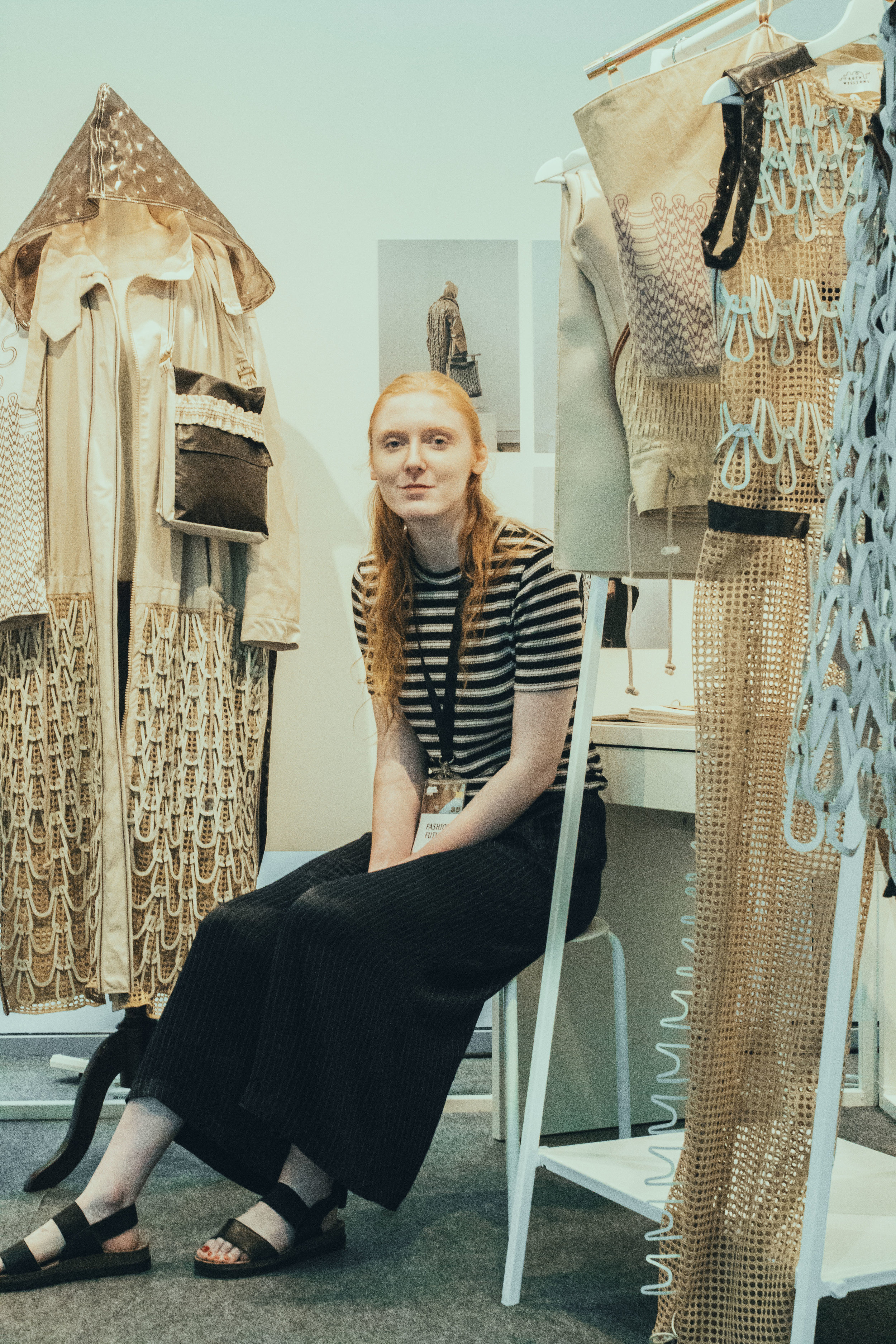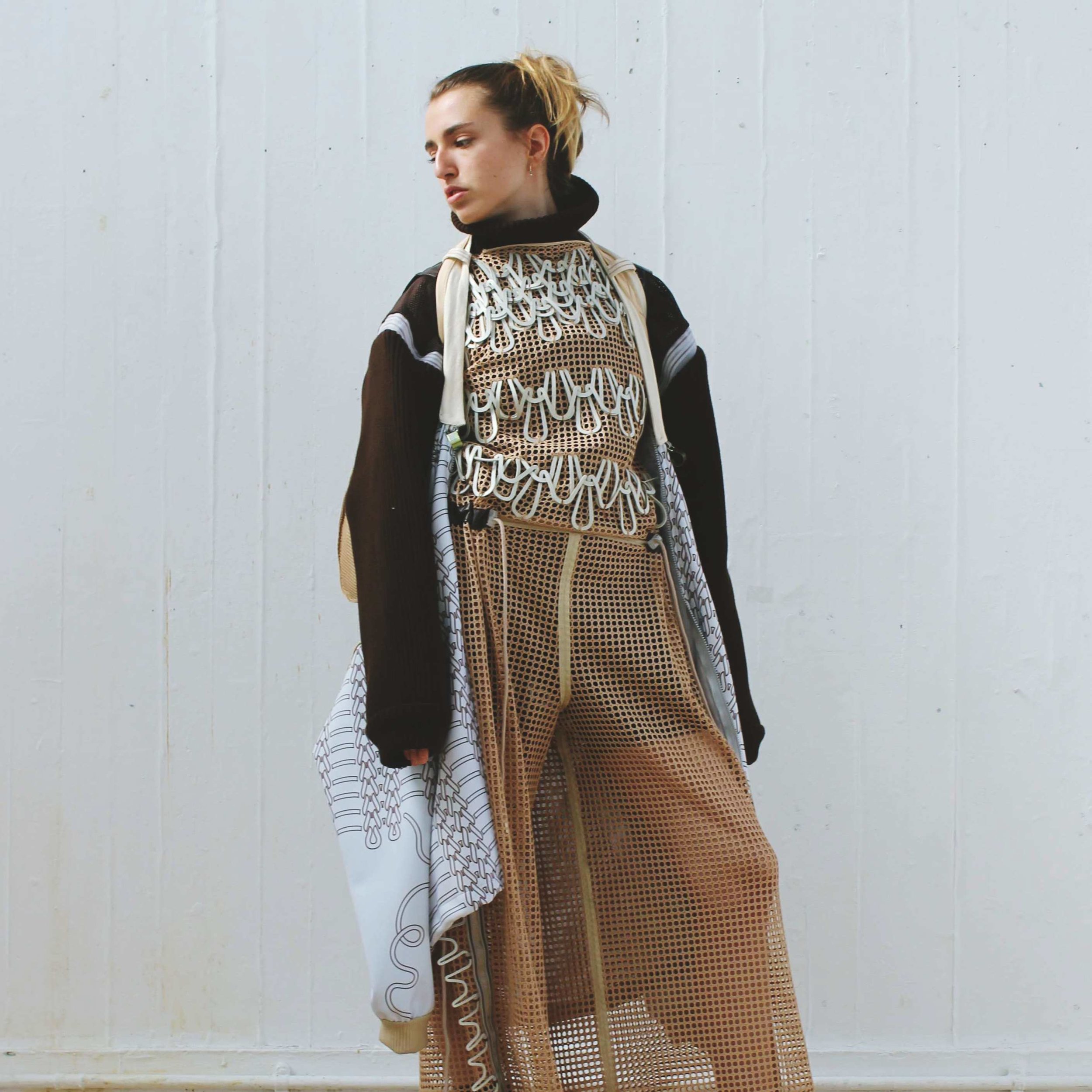Ruth Williams, graduate of Edinburgh College of Art, conscious knitwear designer and Design Assistant at French Connection, has been winning recognition across the country and calling on her experiences of Scottish design history and culture.
We caught up with the emerging designer to learn more about her vision for the future of fashion, how integrating into an established design company works and how her award winning graduate collection has a mind of it's own.
Congratulations on graduating and showcasing at GFW17! How was the entire experience for you?
I had a great time at Graduate Fashion Week. It was so exciting to see everything come together and check out the work from all the other graduates. I was extremely impressed by everything I saw, there’s so much creativity and talent everywhere you look.
A huge well done for winning the Visionary Knitwear award at GFW! The winning collection presented a neutral palette, with an air of elegance. What inspired the collection?
The collection was inspired by vintage cotton tents, minimalism and a love of knitwear, while exploring the concept of protection. At the very beginning of the project I received this beautiful old vintage tent, which had beiges, light pinks and dark brown fabrics with copper hardware, and as I used a lot of the fabrics for final garments, the colour scheme mostly came from there. The laser-cut knitwear evolved quite naturally from looking at artists who’d done interesting things with knit as well as playing around with different materials.
How did the student experience at Edinburgh College of Art prepare you for post- graduate life in the demanding fashion industry?
I really enjoyed studying at Edinburgh. We are always getting pushed to do interesting and innovative work, so the stuff we produce is really exciting and definitely stands out. Because it is such a small course and so far away from London it can be quite hard to do internships and get involved with the industry, so GFW helps a lot in that respect.
Your collection was selected to be showcased at Fashion Forward Dubai last year. How was the experience of showing internationally?
Dubai was a really great experience, I had a lot of fun and got to meet a lot of interesting people and see some cool shows and talks. There’s a real mix of different design and people. The organisers did such a good job arranging the showcase and sorting everything out for us.
Fashion Forward Dubai presented international talent, which in particular celebrated Middle Eastern design talent. Being one of the largest global fashion hubs, Dubai welcomed designers from extremely diverse cultures. Do you try to incorporate culture into your designs?
Yeah I try to incorporate culture into my designs. I was looking at traditional Scottish craft including knitting and weaving and wanted to do something innovative with it. Scotland has a rich history of textiles, and still a lot of luxury brands manufacture there which I don’t think people realise. I wanted to celebrate craft in a very modern and imaginative way.
What influenced you to choose knitwear as your design pathway?
I’ve always really loved knitwear, and I wear a lot of it. Before I started my graduate collection I was doing a knitwear internship in Antwerp with Sigi by Hilde Frunt. I really enjoyed that internship and learnt a lot about knitwear, so when I came back to university I was doing a lot of knit and trying out different yarns/materials. I started knitting with rubber cord, and to be honest it was a bit of a disaster, but when I put it in a heat press i realised that it could be moulded into the shape of a row of knitwear, and the rows could be linked together. This eventually led to me laser cutting sheets of rubber, which is how I made my collection.
Fashion is beginning to focus on sustainability, as climate change becomes more and more of a concern for the younger generation. Do you try to incorporate environmentally conscious techniques into your work?
Yes, a lot of my collection was made out of reused tents. I found unwanted tents on gumtree and was sponsored by the tent company Nordisk, who gave me old prototypes that they had no use for. I wanted to reuse fabrics to reduce textile waste and environmental harm, but also because they’re so unique, practical and you can’t find them in just any fabric shop. Tents are ideal for making into coats and bags because they’re sturdy, waterproof and the poles and fastenings make for some great hardware. Sustainability can provide a lot of opportunities for creativity.
If you could choose one designer or brand to collaborate with in the future, who would it be and why?
At the moment I can’t get enough of Joseph, (Louise Trotter was one of the Knitwear Award judges) I love the use of colour, drape, detail.. It’s all so elegant and well balanced.
Recently, you were awarded the Young Designer of the Year Award at St Andrews! Congratulations. Can you tell me a little more about the award itself and how it felt to be awarded this title?
The Young Designer Award is part of the St Andrews Charity Fashion Show. Its an award that’s been going for 6 years, it basically supports and promotes young designer talent and the work of the finalists is featured in the annual fashion show. I was really happy and surprised to win the award, especially as the work of the other finalists was of such high standard. It always feels great hear that people respond well to my designs.
The last few weeks have been your first days at French Connection! How’re you finding it so far?
So far it’s been really enjoyable, and I’ve been learning so much about design and production. I’m working as a knitwear design assistant, so helping to research, design and do tech packs etc. They have a really nice design process, taking inspiration from vintage as well as contemporary fashion. There’s quite a laid back atmosphere, it’s a good place to work.
If you could give students wanting to showcase at GFW18 some advice, what would it be?
Enjoy it! And don’t stress over the little things. When I started making my collection I remember getting very stressed over things like how neat my bias binding was, or getting the perfect shade of brown sublimation print. You need to be quite ruthless and acknowledge that the collection will take on a life of its own. Nothing goes exactly as planned. Its also important to think carefully about portfolio and cv etc as that’s how you will communicate yourself to judges/employers.
Interview by Annabel Waterhouse-Biggins








